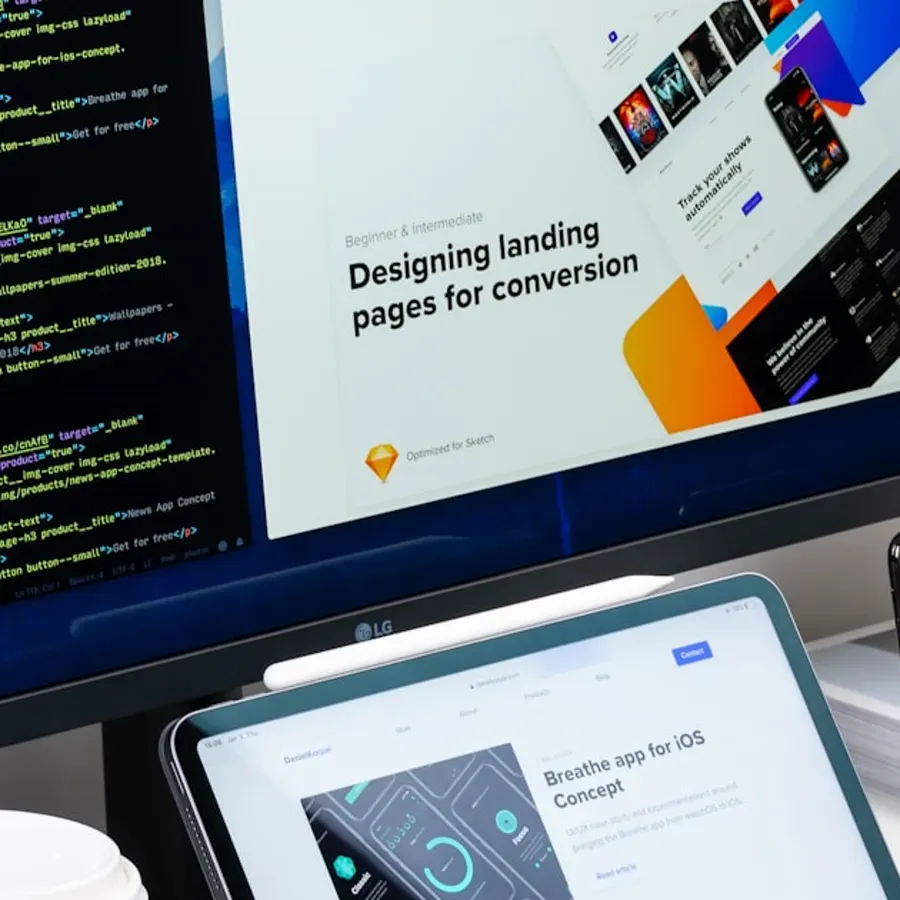
Why HTML5 & CSS3 Matter for Modern Web Development
In the rapidly evolving digital landscape of 2025, HTML5 and CSS3 have become the foundational technologies powering every successful website. These aren't just incremental updates to older web standards—they represent a fundamental shift in how we build, structure, and style web content. HTML5 CSS3 technologies offer semantic markup, enhanced multimedia support, powerful styling capabilities, and responsive design features that make websites faster, more accessible, and significantly more engaging for users across all devices.
The business case for adopting HTML5 and CSS3 is compelling. Websites built with these modern standards load 30-50% faster than legacy alternatives, rank higher in search engine results due to improved semantic structure, and provide seamless experiences across desktop, mobile, and tablet devices. For Australian businesses looking to compete in today's mobile-first marketplace, understanding and implementing HTML5 CSS3 isn't optional—it's essential for survival and growth.
Modern browsers including Chrome, Safari, Firefox, and Edge all provide robust support for HTML5 and CSS3 features, with over 98% browser compatibility across current versions. This widespread support means developers can confidently use advanced features without worrying about fallback solutions for the vast majority of users. The combination of semantic HTML structure and powerful CSS styling capabilities creates websites that are not only visually stunning but also technically sound, accessible to all users, and optimised for search engine discovery.
Semantic HTML Elements: Structure That Speaks
Semantic HTML elements are the backbone of modern web architecture. Unlike generic container elements like div and span, semantic elements such as header, nav, article, section, and footer explicitly describe their content and purpose. This clarity benefits both machines and humans—search engines can better understand your content hierarchy, screen readers can navigate more effectively, and developers can maintain code more easily.
The header element serves as a container for introductory content or navigational links, typically appearing at the top of a page or section. It might contain your site logo, main navigation, search functionality, or other key branding elements. Using header instead of a generic div with a class tells browsers, search engines, and assistive technologies exactly what this content represents, improving both SEO performance and accessibility scores.
The nav element defines navigation links, whether they're your main site navigation, footer links, breadcrumbs, or pagination controls. By wrapping navigation in a dedicated semantic element, you help users with screen readers quickly jump to navigation sections without having to parse through decorative content. This seemingly simple change can dramatically improve the user experience for visitors with disabilities while simultaneously strengthening your site's semantic structure for search engines.
The article element represents self-contained content that could be independently distributed or reused—perfect for blog posts, news articles, product listings, or user comments. Each article should make sense on its own, even when separated from the surrounding page context. This semantic clarity helps content aggregators, RSS readers, and search engines understand which portions of your page represent distinct, shareable content units.
The section element groups related content under a common theme, typically with its own heading. While it might seem similar to div, section carries semantic meaning indicating thematic grouping. You might use sections to separate different topics within an article, or to divide a landing page into distinct content areas like 'Features', 'Benefits', and 'Testimonials'. This structured approach to content organisation significantly improves both code readability and SEO performance.
The footer element typically appears at the bottom of a document, section, or article, containing metadata like copyright information, author details, related links, or contact information. Like header, footer provides semantic clarity that helps both users and search engines understand your content structure. Proper use of these semantic elements creates a clear, hierarchical content structure that forms the foundation for excellent SEO and accessibility.
Beyond Basic Structure: Additional Semantic Elements
HTML5 introduces numerous other semantic elements including aside for tangentially related content, figure and figcaption for images with captions, main for primary content, mark for highlighted text, and time for dates and times. Each of these elements adds semantic meaning that improves content structure, accessibility, and search engine understanding. The aside element works brilliantly for sidebar content, pull quotes, or advertisements—content related to but separate from the main flow. The main element should appear once per page, wrapping your primary content and excluding repeated elements like navigation and footers. This helps screen reader users jump directly to the page's core content.
Modern Form Elements: Enhanced User Input
HTML5 revolutionised web forms with new input types that provide built-in validation, improved mobile experiences, and better semantic structure. These new input types eliminate the need for complex JavaScript validation in many cases while simultaneously improving the user experience across devices, particularly on mobile where appropriate virtual keyboards appear automatically.
The email input type (type='email') provides automatic email validation, ensuring users enter properly formatted email addresses before form submission. On mobile devices, the email keyboard appears automatically, providing quick access to the @ symbol and common email domain extensions like .com and .com.au. This simple change dramatically reduces form errors and improves conversion rates by making it easier for users to enter valid email addresses. You can even use the multiple attribute to allow users to enter several comma-separated email addresses in a single field.
The tel input type (type='tel') displays a numeric keypad on mobile devices, making phone number entry faster and more accurate. While browsers don't enforce tel input validation natively due to the wide variety of international phone number formats, you can use the pattern attribute with regular expressions to validate Australian phone numbers or other specific formats. The placeholder attribute helps guide users toward the expected format, whether that's '04XX XXX XXX' for Australian mobiles or '(02) XXXX XXXX' for Sydney landlines.
The date input type (type='date') creates a native date picker in modern browsers, eliminating the need for complex JavaScript calendar widgets. Users can either type a date or select one from the calendar interface, ensuring properly formatted dates reach your server. Chrome, Safari, Firefox, and Edge all provide excellent date picker support, though Internet Explorer requires JavaScript fallbacks. The date format adapts to the user's locale automatically—Australian users see DD/MM/YYYY while Americans see MM/DD/YYYY, reducing confusion and entry errors.
Additional Input Types for Better Forms
HTML5 includes numerous other input types including number for numeric input with increment/decrement controls, range for slider controls, color for colour pickers, url for website addresses, search for search fields with enhanced styling, and month, week, and time for various date/time inputs. Each type provides appropriate mobile keyboards, built-in validation where applicable, and semantic clarity about the expected input. The number type prevents non-numeric input and provides increment/decrement arrows, perfect for quantity selectors or age inputs. The url type validates URL format and provides the .com key on mobile keyboards. These thoughtful enhancements dramatically improve form usability while reducing the JavaScript code needed for validation and user interface enhancements.
CSS3 Selectors & Properties: Styling Superpowers
CSS3 introduced powerful new selectors and properties that give designers unprecedented control over visual presentation. These features eliminate the need for many JavaScript workarounds and image-based effects that plagued earlier web development, resulting in faster, more maintainable websites with stunning visual effects achieved through pure CSS.
Attribute selectors allow precise targeting based on element attributes and values. You can select elements containing specific attribute values, starting with particular strings, or ending with certain extensions. For example, a[href$='.pdf'] selects all links to PDF files, allowing you to style them distinctively with an icon. The ^= operator matches attributes starting with a string, while *= matches attributes containing a substring anywhere within the value. These powerful selectors reduce the need for excessive classes and IDs.
Pseudo-class selectors including :nth-child(), :nth-of-type(), :first-of-type, :last-of-type, and :only-child enable precise selection of elements based on their position within a parent. The :nth-child(odd) and :nth-child(even) selectors create zebra-striped tables without any JavaScript, while :nth-child(3n) selects every third element. These structural pseudo-classes dramatically simplify common styling patterns that previously required adding classes to specific elements or using JavaScript to apply styles dynamically.
The ::before and ::after pseudo-elements create virtual elements before or after an element's content, perfect for adding decorative elements, icons, or content without cluttering your HTML. Combined with content: '', these pseudo-elements can insert text, images, or decorative elements entirely through CSS. This technique keeps your HTML semantic and clean while achieving sophisticated visual effects. Modern icon systems often use ::before pseudo-elements to inject icon fonts or SVG icons without requiring extra markup.
CSS3 properties including border-radius create rounded corners, box-shadow adds depth with shadows, text-shadow enhances text with shadows, transform rotates or scales elements, and opacity controls transparency. The background property now supports multiple backgrounds, gradient backgrounds with linear-gradient() and radial-gradient(), and precise background sizing and positioning. These properties eliminate countless images and JavaScript tricks that slowed down earlier websites, replacing them with efficient, scalable, pure-CSS solutions.
Advanced CSS3 Features
CSS3 filters apply visual effects like blur, brightness, contrast, grayscale, and saturation directly to elements without image editing software. The calc() function performs calculations within CSS, letting you mix units like calc(100% - 50px) for flexible layouts. Custom properties (CSS variables) enable theme systems and consistent design tokens throughout your stylesheet. The @supports rule provides feature detection, allowing progressive enhancement with fallbacks for older browsers. These advanced features give designers capabilities that were previously impossible or required complex JavaScript implementations.
Flexbox & Grid Layouts: Modern Layout Systems
CSS Flexbox and Grid represent the most significant advancement in web layout since the introduction of CSS itself. These layout systems replace the float-based and table-based hacks that dominated web development for decades, providing purpose-built tools for creating sophisticated, responsive layouts with clean, maintainable code.
Flexbox excels at one-dimensional layouts—arranging items in a single row or column. It's perfect for navigation bars, card layouts, form layouts, and any situation where you need flexible space distribution along a single axis. The container uses display: flex, while properties like justify-content, align-items, flex-direction, and flex-wrap control layout behaviour. Items automatically adjust their size to fill available space or shrink to prevent overflow, creating truly flexible layouts that adapt to content and viewport size.
CSS Grid handles two-dimensional layouts, managing both rows and columns simultaneously. It's ideal for page layouts, magazine-style content grids, dashboard interfaces, and any design requiring precise control over both horizontal and vertical positioning. Grid uses display: grid with properties like grid-template-columns, grid-template-rows, gap, and grid-template-areas to create sophisticated layouts. The grid-template-areas property is particularly powerful, letting you define layout areas with intuitive string syntax that creates a visual representation of your layout directly in the CSS.
The industry consensus in 2025 is clear: use Grid for macro layout—defining your overall page structure with headers, footers, sidebars, and content zones—then use Flexbox for micro layout within those grid areas, arranging buttons, form elements, cards, and other components. This hybrid approach combines Grid's two-dimensional power with Flexbox's one-dimensional flexibility, giving you the perfect tool for every layout challenge.
Both Flexbox and Grid enjoy excellent browser support, with over 98% compatibility across current browsers. Frontend Masters research found developers using Grid for layouts complete responsive designs 30% faster than those relying solely on Flexbox or float-based layouts. This efficiency translates directly to reduced development costs and faster time to market for your web projects. The code is also more maintainable, with layout logic clearly expressed in CSS rather than hidden in complex calculations and positioning hacks.
Responsive Layouts Made Simple
Flexbox and Grid integrate seamlessly with media queries to create responsive layouts that adapt beautifully across devices. A Grid layout might use a single column on mobile, two columns on tablets, and three or four columns on desktop—all controlled with a few lines of CSS in a media query. Flexbox navigation might stack vertically on mobile then expand horizontally on desktop. The auto-fit and auto-fill values in Grid create responsive column counts without media queries, automatically adjusting based on available space and minimum column width. These responsive features make building mobile-friendly websites dramatically simpler than older techniques required.
Animations & Transitions: Motion That Matters
CSS3 animations and transitions bring websites to life with smooth, performant motion effects that enhance user experience without requiring JavaScript or external animation libraries. These pure-CSS effects are hardware-accelerated in modern browsers, delivering 60fps animations that feel buttery smooth even on mobile devices.
CSS transitions create smooth changes between property values over a specified duration. When a property changes—through hover effects, class changes, or any CSS modification—transitions smoothly interpolate between the old and new values rather than changing instantly. The transition property specifies which properties to animate, the duration, timing function (ease, linear, ease-in, ease-out, ease-in-out), and delay. Transitions are perfect for hover effects, button states, form focus states, and any interface element that changes between discrete states.
CSS animations provide more complex, keyframe-based animations that can loop infinitely, run a set number of times, alternate directions, and include multiple animation steps. The @keyframes rule defines animation stages, while the animation property on an element triggers the animation. You can animate multiple properties simultaneously, creating sophisticated effects entirely in CSS. Animations are ideal for loading spinners, attention-grabbing elements, decorative effects, and any motion that runs without direct user interaction.
Transform animations using translate, rotate, scale, and skew create visually impressive effects while remaining performant. Browsers can hardware-accelerate transform and opacity animations, making them significantly smoother than animating properties like width, height, or position. Modern web design best practices recommend using transform: translateX() for horizontal movement rather than animating left or right, and transform: scale() for size changes rather than animating width and height, as these transform-based animations perform better on all devices, especially mobile.
Animation Best Practices
Use animations purposefully to enhance user experience rather than distract from content. Subtle transitions on hover states, smooth page transitions, loading indicators, and attention-directing animations improve usability when done well. Excessive animation, long durations, or motion that serves no purpose can frustrate users and make your site feel unprofessional. The prefers-reduced-motion media query respects user preferences for reduced animation, important for accessibility and users with motion sensitivity. Always test animations on actual devices to ensure smooth performance, as desktop performance doesn't always reflect mobile reality.
Responsive Design Features: One Web For All Devices
HTML5 and CSS3 provide comprehensive tools for responsive design—creating websites that adapt beautifully to any screen size from smartwatches to large desktop displays. This mobile-first approach isn't optional in 2025; with over 60% of web traffic coming from mobile devices in Australia, responsive design is essential for reaching your audience where they are.
The viewport meta tag (meta name='viewport' content='width=device-width, initial-scale=1.0') forms the foundation of responsive design, ensuring mobile browsers render your site at the device width rather than at a desktop width and zooming out. Without this tag, mobile browsers assume your site is desktop-only and display it zoomed out, making text unreadable without pinching and zooming. This simple meta tag transforms the mobile experience from frustrating to functional.
CSS media queries detect device characteristics like screen width, height, orientation, and resolution, allowing you to apply different styles based on these conditions. The mobile-first approach starts with mobile styles as the baseline, then uses min-width media queries to enhance the design for larger screens. This approach ensures a solid mobile foundation while progressively enhancing for desktop capabilities. Common breakpoints include 768px for tablets and 1024px or 1200px for desktop layouts, though your content should ultimately dictate breakpoint locations rather than following rigid device sizes.
Flexible units including percentages, viewport units (vw, vh, vmin, vmax), and em/rem units create layouts that scale proportionally rather than breaking at fixed pixel sizes. The calc() function combines different units, enabling calculations like calc(100% - 300px) for sidebars. Container queries, gaining support in 2025, allow components to respond to their container's size rather than the viewport size, enabling truly modular responsive components that work in any context.
Responsive Images and Media
The picture element and srcset attribute provide responsive images, serving appropriately sized images based on device capabilities and viewport size. This dramatically reduces mobile bandwidth usage by avoiding full-resolution desktop images on phones. The picture element can also serve different image crops for different aspect ratios—perhaps a wide landscape photo on desktop and a taller crop showing the key subject on mobile. Modern formats like WebP and AVIF provide superior compression, and the picture element can specify these with fallbacks to JPEG for older browsers. For video, the video element supports multiple sources with automatic format selection.
Browser Compatibility: Widespread Support in 2025
Browser support for HTML5 and CSS3 has matured dramatically, with current versions of all major browsers providing excellent compatibility. Chrome, Safari, Firefox, and Edge all support virtually all HTML5 and CSS3 features discussed in this article, with over 96% of users worldwide running browsers with full support. This widespread compatibility means developers can confidently use modern features without excessive fallback code.
The death of Internet Explorer has been the most significant development in browser compatibility. Microsoft officially ended IE11 support in 2022, and by 2025, IE usage has dropped below 0.5% globally and in Australia. This means you can safely ignore IE-specific bugs and workarounds that plagued developers for years, focusing instead on building for modern browsers that follow web standards. For enterprise clients still supporting IE11, clear communication about the security and performance costs of supporting obsolete browsers is essential.
Feature detection using @supports in CSS or Modernizr in JavaScript allows progressive enhancement—providing basic functionality for all browsers while enhancing the experience for browsers supporting advanced features. This approach ensures your site works everywhere while taking advantage of cutting-edge features where available. For example, you might provide a simple layout for older browsers while using CSS Grid for browsers supporting it, detected via @supports (display: grid).
Can I Use (caniuse.com) remains the definitive resource for checking browser support for specific features. When planning a project, checking support percentages for critical features helps inform technology choices. Features with 95%+ support are generally safe to use with minimal fallbacks, while features with lower support might require polyfills or alternative approaches for wider compatibility.
Mobile Browser Considerations
Mobile Safari on iOS and Chrome on Android dominate mobile browser usage, together accounting for over 80% of mobile traffic in Australia. Both provide excellent HTML5 CSS3 support, though some subtle differences exist in implementation. Testing on actual devices remains important, as desktop simulators don't perfectly replicate mobile browser behaviour. Samsung Internet, used by many Samsung device owners, generally provides good standards support based on Chromium. The key is testing on the browsers your specific audience uses, verified through your analytics data.
Performance Benefits: Speed That Sells
Websites built with modern HTML5 CSS3 techniques consistently outperform legacy alternatives in speed, responsiveness, and overall user experience. These performance improvements translate directly to business results—faster websites convert better, rank higher in search results, and provide superior user experiences that build customer loyalty and trust.
CSS-based visual effects replace image-heavy designs, dramatically reducing page weight and load times. A gradient background created with linear-gradient() requires zero bytes of image data compared to a background image that might weigh 100KB or more. Rounded corners via border-radius eliminate corner images. Icon fonts or SVG icons replace numerous small icon images. These optimisations compound across a site, often reducing total page weight by 40-60% compared to image-heavy legacy designs.
Semantic HTML structure loads and renders faster than div-heavy non-semantic markup. Browsers parse semantic elements more efficiently, and the clearer structure reduces CSS complexity, resulting in smaller stylesheet files and faster rendering. Search engines can parse and understand semantic content faster, improving crawl efficiency. Accessibility tools navigate semantic structures more quickly, improving the experience for users with disabilities. These benefits multiply across thousands of pages, significantly impacting site-wide performance.
Hardware-accelerated CSS animations dramatically outperform JavaScript animations or animated GIFs. Browsers can offload transform and opacity animations to the GPU, achieving smooth 60fps motion without impacting main thread performance. This means animations don't interfere with page responsiveness—users can continue interacting with your site even during complex animations. In contrast, JavaScript animations often cause janky, stuttering motion, especially on mobile devices or when the main thread is busy with other tasks.
Responsive design eliminates separate mobile sites, reducing maintenance costs and avoiding duplicate content SEO issues. A single responsive site works everywhere, with appropriate resources loaded for each device. Mobile users receive appropriately sized images and CSS, not desktop assets, reducing mobile page weight by 50-70% compared to forcing mobile browsers to load desktop resources. This mobile performance improvement is critical in Australia where mobile connections often have limited bandwidth or data caps.
Core Web Vitals and SEO
Google's Core Web Vitals—Largest Contentful Paint (LCP), First Input Delay (FID), and Cumulative Layout Shift (CLS)—directly impact search rankings. Sites built with HTML5 CSS3 best practices naturally achieve better Core Web Vitals scores. Semantic HTML reduces DOM complexity, improving LCP. CSS animations don't block the main thread, reducing FID. Properly sized images and elements with defined dimensions prevent layout shift, improving CLS. These technical improvements translate to better search rankings, more organic traffic, and ultimately more business.
Why Choose M&M for Your HTML5 & CSS3 Development
At M&M Digital Marketing, we specialise in building modern, performant websites using the latest HTML5 and CSS3 standards. Our team of experienced developers understands not just how to use these technologies, but why they matter for your business success. We build websites that are fast, accessible, SEO-optimised, and maintainable—delivering real business value, not just impressive technical specifications.
Our development process starts with understanding your business goals, target audience, and competitive landscape. We don't just build websites; we create digital experiences that achieve your business objectives whether that's generating leads, selling products, building brand awareness, or providing customer service. Our HTML5 CSS3 expertise ensures your site loads quickly, ranks well in search results, works flawlessly on all devices, and provides an excellent user experience that converts visitors into customers.
We follow mobile-first responsive design principles, ensuring your site works beautifully on smartphones, tablets, and desktop computers. Our semantic HTML structure provides excellent SEO foundations, while our CSS3 styling creates visually stunning designs that reflect your brand identity. We implement performance best practices including optimised images, efficient code, and modern responsive techniques that make your site blazingly fast even on mobile connections.
Our commitment extends beyond launch. We provide ongoing support, security updates, and performance monitoring to ensure your site continues performing optimally as your business grows and web technologies evolve. We're not just developers—we're long-term partners invested in your digital success. Our Australian-based team understands local market conditions, user expectations, and business requirements, providing personalised service and support in your timezone.
Whether you need a complete website rebuild using modern standards, performance optimisation for an existing site, or ongoing development support for new features and improvements, M&M Digital Marketing brings the HTML5 CSS3 expertise and business understanding to deliver exceptional results. Our portfolio includes successful projects across diverse industries including retail, professional services, hospitality, healthcare, and more—all built on foundations of semantic HTML and modern CSS.
Get Started With Modern Web Standards Today
Ready to transform your web presence with HTML5 and CSS3? Contact M&M Digital Marketing today to discuss your project requirements and discover how modern web standards can accelerate your business growth. Our team is ready to answer your questions, provide expert recommendations, and develop a comprehensive strategy for your digital success.
Call us at 0909 123 456 or email hello@mmcom.vn to schedule your free consultation. Let's build something extraordinary together—a website that's fast, beautiful, accessible, and optimised for the modern web. Your competitors are already leveraging HTML5 and CSS3; isn't it time you did too?
M&M Digital Marketing—your partner for modern web development that delivers measurable business results through technical excellence and strategic thinking.






